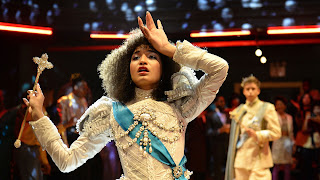by AJ Craig
LGBT History Month is a time to reflect on and pay tribute to both well known and forgotten figures in queer history which means there is no better time to watch some of the best queer stories that television and film have to offer. It’s definitely safe to say that queer fashion and queer history go hand in hand especially in the pivotal years between the 1980s and 1990s where threats and hatred to the community were at a fever pitch. Today, we’ll look at three pieces of historical film and television and how the costume and fashion reflect the events of the era.
The 2014 historical dramedy, Pride, is a lesser known, severely underrated queer historical film that tells the story of the formation and acts of activist group LGSM – Lesbians and Gays Support the Miners.
The film documents the struggles of living in Thatcher era Britain from the perspectives of both the LGBT community and the mining community in Wales and Northern England. Main characters include; Mark Ashton, played by Ben Schweitzer, co-founder of LGSM, and spearhead of the group alongside Jonathan Blake and Gethin Roberts, played by Dominic West and Andrew Scott respectively.
The fashion and costume design in Pride is very indicative of Thatcher era 80s England with pin-covered leather jackets, open chested white shirts and home dyed hair being some of the most notable characteristics. Lone lesbian LGSM member, Steph (played by Faye Marsay) has the most distinctive style of the main group. She is always shown on screen dressed in colours reminiscent of the original lesbian pride flag and her orange hair singles her out from the rest of the group and emphasises her key role as the only lesbian in LGSM. The inspirations behind Steph’s outfits range from Annie Lennox and Madonna to David Bowie as she incorporates mens shirts and braces in her outfits.
The acclaimed Channel 4 limited series It’s A Sin by Russel T. Davies focuses on the struggle with HIV and AIDS and it’s emergence in the UK. The series as a whole is in a word: heartbreaking.
It’s a Sin is some of the most emotive television I have watched in a long time and depicts the AIDS crisis in its most raw, exposed form. Aside from the seriousness of the subject matter and finale of the show, it is an effervescent watch and as all of the items on this list depict, have beautiful examples of queer joy and happiness.
Fashion wise, let’s focus on Richie and Roscoe. Played by Years and Years frontman, Olly Alexander, Richie Tozier’s hallmark is his blue wash denim jacket, high styled hair and floaty shirts. After arriving at university, Richie initially wears collared shirts and jumpers for a more ‘collegiate’ look. This changes as he gets more into the club scene and he begins to were more of his floaty, silky shirts, most notably seen in a montage about the legitimacy of HIV and its dangers.
Roscoe, played by Omari Douglas, has one of the most memorable scenes in the show when he comes out to his Lagos native family in the most flamboyant way possible before leaving the family and living with his friends in the ‘Pink Palace’. His outfit of a mini skirt, crop top and purple headscarf as well as the additions of a clear umbrella and suitcase make the scene completely. By wearing such a skimpy outfit in the London rain, he proves that truly and completely, no longer cares about the opinions and oppressions around him and moves onto a place where he is accepted and care for amount his friends.
A final example of queer fashion depicted on television is in Ryan Murphy’s Pose. Set in 1987 – 98 New York and follows the lives the several trans women who navigate both the world of ballroom culture and 80s 90s social discourse surrounding homophobia, transphobia and the emergence of HIV.
The entire series of filled with beautifully intricate and OTT outfits but the scene that sets of tone for the series in both character and fashion is in the first episode of the series. Electra and the rest of the house of Abundance rob a nearby museum of its royal clothing displays and wear the stolen outfits to a ball event: category is Royalty of course. Dripping in pearls, royal blues purples and gold trims as they are dragged away by police, there is something incredibly iconic about this pilot episode.
This opening scene is just the start of many fashion ball scenes for the series and they just get better and better as the seasons progress but it is incredibly hard to top the energy behind robbing a museum exhibit in heels and a white fur outfit to simply be crowned ‘The Best’. Pose is greatly influenced by both ballroom culture and the transition of 80s fashion into the 90s, examples of which can be seen in the documentary Paris is Burning and through shows such as Queer as Folk and icons such as RuPaul Charles.



